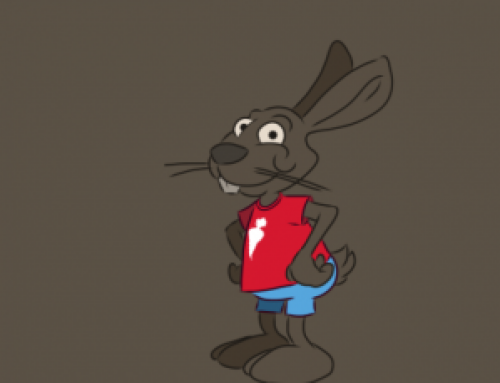Suitable for:
- 1 or more players
- Outdoor or indoor area
- Range of physical literacy: Hand-eye skills
- Age appropriate: 3-7years
Primary physical literacy skills: reaction time, hand eye coordination,
balancing, jumping, crouching, core strength, mobilising joints
Make it happen
 You can make a hand speed wall using a blank space on the wall or a closed door with stickers or pieces of paper stuck on with blue tac (you can use stickers that are designed to be peeled off and re-applied).
You can make a hand speed wall using a blank space on the wall or a closed door with stickers or pieces of paper stuck on with blue tac (you can use stickers that are designed to be peeled off and re-applied).- If you have an outdoor wall or fence you can consider using chalk to mark out shapes.
- Place stickers at different heights (high, low, medium), either in rows or randomly spaced.
You can use the wall as part of some interval exercises. Run each interval for a set time period (e.g. 30 seconds) Some ideas for intervals:
- For the first 30 second interval, call out different stickers on the wall to touch at different heights and left or right. Children can reach overhead on tiptoes to touch the highest and crouch down to reach the lowest.
- Every 30 seconds they should alternate between the wall and another exercise. g. 1.wall, 2. higher energy activity, 3. wall, 4. lower energy activity.See below for ideas.
Some ideas:
High energy
- Indoors – star jumps, lie on belly/jump up in the air, two footed jumps forwards/backwards/side to side
- Outdoors – run some laps, skip with a skipping rope, hop-scotch up and down a line.
Low energy
- Indoors – marching on the spot, dancing, balancing on one leg or with feet together and trying to find lean out in different directions
- Outdoors – bouncing and catching a ball on the ground, alternate galloping and walking some laps, tightrope walking along a line
Try to make the total exercise time for each child at least 10 minutes. If you have more than one child then one could be on the wall while the others rotate through the other activities
- Ensure that the movement the children are performing is suitable for the space you have available.
- Make sure the time interval you are setting is appropriate for the level of each child.
- It may be necessary to have different time intervals for different activities e.g. shorter for higher energy and longer for lower energy activities.
- If you have stickers set up on different walls (see Make it more energetic) then ensure the activity area between all the walls is clear of any obstructions (including people).
We provide this list only as a guide of what parents/carers may wish to consider. Please also read our general guidelines on the Parents/Carers Information page.
Expand the headings below for suggestions to make more use of this activity and keep you and your children coming back for more
- Stickers could be different shapes or colours or could have pictures on them such as Superheroes, cartoon characters, countries, animals, etc. See Make your equipment suitable below for ideas to make your own stickers.
- See if you can link the stickers to the other activities.
Some ideas: Superheroes. Call out different stickers on the wall: Hulk, Spiderman, Wonder-woman, Batman. Then for the next 30 seconds tell them to chase some jewel thieves around the garden.
- See if you can relate any equipment to the theme you may be using. Some ideas: if the stickers have a seaside theme, then a balloon could be a beach ball, a towel laid out on the ground could be a surf board to balance on, etc.
- Leaper’s theme: If you have animal stickers then Swingy the gibbon takes us on a tour around Africa. Touch the stickers, e.g. giraffe, zebra, lion, rhino, snake; then the children move around the activity area pretending to swing on vines, jump into lakes, climb trees, walk along branches, etc.
Please also read our general guidelines on the Parents/Carers Information page.
- For a coordination challenge you could get them to use their feet to touch the bottom stickers and their hands for the top and middle ones.
- Count how many stickers each child can touch within the time period, see if they can beat their own scores.
- How long does it take them to complete a sequence of the stickers? Some ideas: touch every sticker in each row from top to bottom with both hands; or touch one from the top, one from the middle, one from the bottom, then back to top, middle, bottom, etc.
Please also read our general guidelines on the Parents/Carers Information page.
Always make sure whatever equipment you are using is safe and appropriate for that use.
- If you don’t have peel-able stickers then you could buy normal stickers and stick them to cut out pieces of blank card or paper. Put blue tac on the pieces of card/paper and apply them to the wall.
- You print out pictures from the internet and cut them out and apply with blue tac.
Please also read our general guidelines on the Parents/Carers Information page.
- Add in more rows of stickers and place some high enough that the children will need to jump up to touch them, and spread some out so the children have to move sideways back and forth along the wall or really stretch wide with their arms.
- Increase the speed you call out the different stickers so that it’s a challenge for the children to react.
- For 5-7yrs you could call out which hand to use e.g. left red, right blue, left yellow, etc.
- Have different stickers on different walls in the activity area so that they need to move around quickly to different places (you can tell them different ways to move; e.g running, hopping, crawling, skipping, walking with a beanbag on their heads, etc). See Make it safe
Please also read our general guidelines on the Parents/Carers Information page.
Printable PDF download here
Use of the resources
This move to improve resource is provided as a guideline only for parents and carers who wish to supervise physical activities for their children. Users of this resource have a duty of care to ensure the safety of their participants. We do not endorse the use of any content in this resource that a user feels may present a risk to the safety or well being of the children in their care.








